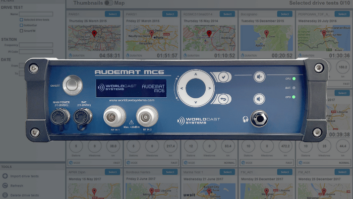The National Association of Broadcasters supports the proposed use of a new wireless microphone technology if the Federal Communications Commission allows it on a “secondary basis” with “prudent restrictions” on its operations.
The technology is called the Wideband Multichannel Audio System. It was first proposed by Sennheiser and is being actively supported by Shure, which has made several presentations to FCC staff about it.
The commission has been taking comments on whether WMAS technology should be granted on a licensed basis in frequency bands where wireless mics are already authorized. This includes TV bands, the 600 MHz duplex gap and in portions of the 900 MHz, 1.4 GHz and 7 GHz bands. The NPRM also looks at using WMAS on an unlicensed basis.
In comments filed Monday, the NAB said WMAS could help relieve spectrum congestion in situations where a large number of wireless microphones are needed.
But because WMAS “has a greater potential for interference and is not compatible with legacy narrowband wireless microphone deployments,” NAB said, the FCC should put restrictions in place to “help reduce the potential for interference to primary spectrum users and to ensure that spectrum efficiency is actually improved.”
Notably, the NAB says the commission should limit WMAS operations to large events.
“WMAS systems occupy more spectrum than traditional wireless microphone systems. As a result, the use of WMAS systems has a preclusive effect on traditional systems where spectrum is limited. For example, if there is only a single 6 MHz TV channel available for use at a breaking news event, one news crew using a WMAS system could occupy the entire channel and prevent coverage by other news organizations.”
So the association said the commission should limit use of the technology to situations where a large number of audio channels are needed and all channels are under control of one entity, such as arena concerts, big sporting events, TV and movie production and major theatrical shows. It suggested that an appropriate threshold would be 10 audio channels in use by a single entity.
“As an added measure, NAB suggests the commission only authorize WMAS base stations that are designed to prevent transmission when fewer than 10 paired audio devices are detected.”
NAB also said the FCC should require a minimum efficiency of six audio channels per megahertz.
“The commission’s proposal of at least three audio channels per megahertz appears to represent no meaningful efficiency improvement, particularly if the audio channels are not of broadcast or production/performance quality. … Based upon marketing information from one of the petitioners, existing digital wireless microphone systems can support at least 47 audio channels in a six MHz RF channel, albeit with some restrictions, corresponding to a spectrum efficiency of 7.8 channels per MHz. NAB understands that WMAS can support up to 64 audio channels in 6 MHz of RF bandwidth, corresponding to an efficiency of 10.7 channels per MHz. A baseline efficiency requirement for WMAS of six channels per MHz would thus represent an improvement upon what is available using existing technologies but be comfortably below the theoretical maximum efficiency of WMAS technology.”
The association asked the commission to restrict WMAS eligibility to Part 74 licensees and to limit the new systems to 6 MHz bandwidth.
And NAB agrees with an FCC proposal to limit these systems to 250 mW EIRP in the UHF television bands, regardless of the bandwidth of the WMAS operation.
“NAB believes this 250 mW power level would be sufficient power to accommodate a large number of WMAS audio devices while reasonably limiting the co-channel interference potential to that of conventional wireless microphone deployments. An EIRP limit of 250 mW also maintains the necessary protection of WMAS to television stations operating on adjacent channels.”







